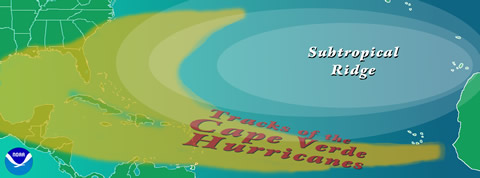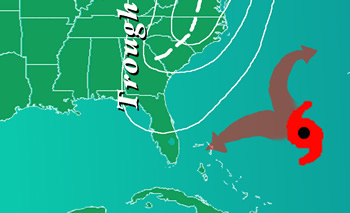|
Back to Tropical Cyclones Climatology Page | Back to Main FAQ Page Subject: G5) What determines the movement of tropical cyclones? Contributed by Chris Landsea (NHC) Tropical cyclones - to a first approximation - can be thought of as being steered by the surrounding environmental flow throughout the depth of the troposphere (from the surface to about 12 km or 8 mi). Dr. Neil Frank, former director of the U.S. National Hurricane Center, used the analogy that the movement of hurricanes is like a leaf being steered by the currents in the stream, except that for a hurricane the stream has no set boundaries. 
In the tropical latitudes (typically equatorward of 20°-25°N or S), tropical cyclones usually move toward the west with a slight poleward component. This is because there exists an axis of high pressure called the subtropical ridge that extends east-west poleward of the storm. On the equatorward side of the subtropical ridge, general easterly winds prevail. However, if the subtropical ridge is weak - often times due to a trough in the jet stream - the tropical cyclone may turn poleward and then recurve back toward the east. On the poleward side of the subtropical ridge, westerly winds prevail thus steering the tropical cyclone back to the east. These westerly winds are the same ones that typically bring extratropical cyclones with their cold and warm fronts from west to east. 
Many times it is difficult to tell whether a trough will allow the tropical cyclone to recurve back out to sea (for those folks on the eastern edges of continents) or whether the tropical cyclone will continue straight ahead and make landfall. For more non-technical information on the movement of tropical cyclones, see Pielke and Pielke's "Hurricanes: Their Nature and Impacts on Society". For a more detailed, technical summary on the controls on tropical cyclone motion, see Elsberry's chapter in "Global Perspectives on Tropical Cyclones". |
TC FAQ
Links of Interest
AOML Tools & Resources
Employee Tools
|
